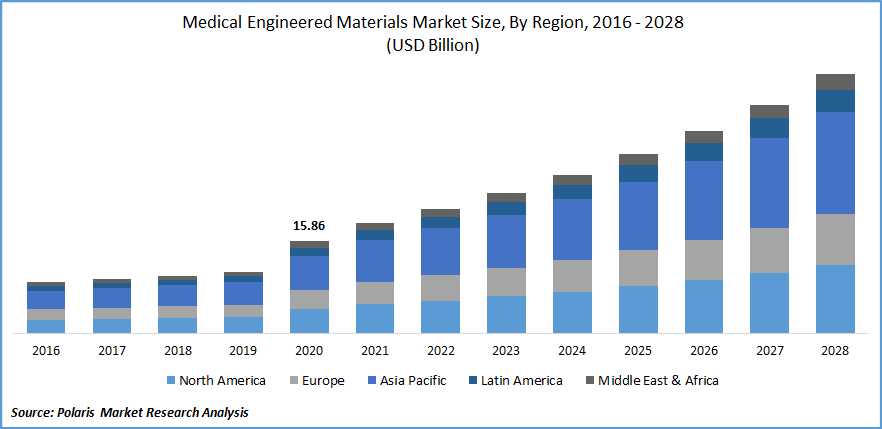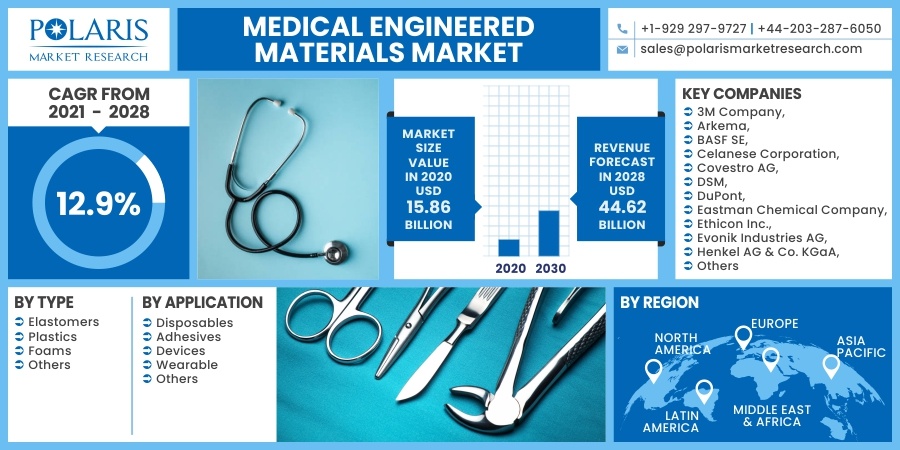
Medical Engineered Materials Market Share, Size, Trends, Industry Analysis Report, By Type (Elastomers, Plastics, Foams, Others); By Application; By Region; Segment Forecast, 2021 - 2028
- Published Date:Oct-2021
- Pages: 101
- Format: PDF
- Report ID: PM2127
- Base Year: 2020
- Historical Data: 2016 - 2019
Report Summary
The global medical engineered materials market size was valued at USD 15.86 billion in 2020 and is expected to grow at a CAGR of 12.9% during the forecast period. The medical engineered materials market is experiencing growth due to the rising population and the growing need to enhance patient experience.
 Know more about this report: request for sample pages
Know more about this report: request for sample pages
Medical engineered materials include adhesives, elastomers, foams, and plastics, among others. There is continuous innovation in these materials to enhance the quality and longevity of healthcare equipment. These materials are chemical, temperature, and corrosion resistant for the development of safe and effective devices.
Medical engineered materials are used to manufacture disposables, wearables, equipment, surgical instruments, and implants. The greater need for reducing healthcare-associated infections (HAIs), adopting portable technologies, and improving healthcare regulations has boosted the demand for medical engineered materials across the globe.

Know more about this report: request for sample pages
Industry Dynamics
Growth Drivers
The global medical engineered materials market is driven by rising healthcare expenditure, increasing geriatric population, and rising cases of lifestyle diseases. Globally, significant investments are being made in the healthcare industry to improve infrastructure and develop technologically advanced devices. The growing popularity of minimally invasive procedures further supports the market growth for engineered materials.
Changing consumer lifestyles, rising awareness of diseases such as cancer and diabetes, and growing demand from developing countries are just a few of the factors driving the market for engineered materials. Governments across the globe are introducing strict healthcare regulations, encouraging market players to develop effective and patient-friendly medical devices.
The adoption of plastics for the development of equipment has increased due to their lightweight, durability, and cost-efficiency. Healthcare-grade polypropylene and medical-grade polycarbonate are polymers used in a wide range of applications such as surgical tools, MRI casings, pill casings, internal implants, catheters, and joint replacements, among others.
Medical plastics are easy to sterilize and offer superior safety. They are used for the transportation of biohazardous waste as they are non-permeable and shatterproof. The adoption of 3D printing for development of equipment has increased the market demand for engineered plastics. They are used for implants and prosthetics owing to greater freedom of customization and hypoallergenic property.
The market demand for medical engineered materials has increased during the pandemic. There has been a significant rise in the use of masks, PPE kits, and gloves during the pandemic. The fear of contracting the disease has encouraged consumers of all ages to use physical protection against the virus.
The shortage of disposables and wearables has urged organizations to boost production and enhance infrastructure. Healthcare facilities are in dire need of face shields, respirators, infrared thermometers, gowns, and goggles. The requirement for ventilators and ventilator accessories, oxygen concentrators, and blood glucose meters has increased, supporting the sale of medical plastics, medical films, and medical elastomers.
Report Segmentation
The market is primarily segmented on the basis of type, application, and region.
|
By Type |
By Application |
By Region |
|
|
|
Know more about this report: request for sample pages
Insights by Type
On the basis of type, the engineered materials market is segmented into elastomers, plastics, foams, and others. There has been a high market demand for plastics during the forecast period. Medical plastics are used for the development of test equipment, surgical instruments, catheters, and implants. They offer high performance, are lightweight, and lower costs.
Some plastic surfaces also offer antimicrobial properties and repel or kill microbes. Medical-grade plastics are utilized in the development of prosthetics through injection molding. Highly customized, lightweight and durable prosthetics are designed by leading manufacturers using medical engineered plastics.
Insights by Application
The application segment of healthcare engineered materials has been divided into disposables, adhesives, devices, wearable, and others. The disposables segment dominated the global market in 2020 owing to greater market demand for surgical instruments, diagnostic disposables, and accessories, among others. These are developed for single-use due to concerns regarding the spread of diseases. These products are cost-effective and easy to process.
Geographic Overview
Asia Pacific healthcare engineered materials is expected to grow at a significant rate during the forecast period. Increasing population, rising cases of lifestyle-associated diseases, and improving healthcare infrastructure have increased the region's demand for engineered materials in healthcare.
Growing research & development activities and technological advancements in 3D printing and medical manufacturing are some factors attributed to the growth of this region. The outbreak of COVID-19 has significantly increased the demand for disposables and devices such as ventilators to care for critically ill patients in the region.
Competitive Landscape
The leading players in the medical engineered materials industry include 3M Company, Arkema, BASF SE, Celanese Corporation, Covestro AG, DSM, DuPont, Eastman Chemical Company, Ethicon Inc., Evonik Industries AG,Henkel AG & Co. KGaA, Huntsman Corporation, Koninklijke DSM N.V., Nitto Denko, SABIC, Sekisui Chemical, Solvay S.A., Teknor Apex Company, Trelleborg AB, Trinseo.
To expand their customer base and strengthen their market presence, these companies are expanding their presence across various geographies and entering new markets in developing regions. To meet rising consumer demands, companies are also introducing new innovative products to the engineered materials market.
Medical Engineered Materials Market Report Scope
|
Report Attributes |
Details |
|
Market size value in 2020 |
USD 15.86 billion |
|
Revenue forecast in 2028 |
USD 44.62 billion |
|
CAGR |
12.9% from 2021 - 2028 |
|
Base year |
2020 |
|
Historical data |
2016 - 2019 |
|
Forecast period |
2021 - 2028 |
|
Quantitative units |
Revenue in USD million/billion and CAGR from 2021 to 2028 |
|
Segments covered |
By Type, By Application, By Region |
|
Regional scope |
North America, Europe, Asia Pacific, Latin America, Middle East & Africa |
|
Key Companies |
3M Company, Arkema, BASF SE, Celanese Corporation, Covestro AG, DSM, DuPont, Eastman Chemical Company, Ethicon Inc., Evonik Industries AG, Henkel AG & Co. KGaA, Huntsman Corporation, Koninklijke DSM N.V., Nitto Denko, SABIC, Sekisui Chemical, Solvay S.A., Teknor Apex Company, Trelleborg AB, Trinseo. |
License and Pricing
Purchase Report Sections
- Regional analysis
- Segmentation analysis
- Industry outlook
- Competitive landscape
Connect with experts
Suggested Report
- Vascular Access Device Market Share, Size, Trends, Industry Analysis Report, 2021 - 2028
- Air Cushion Packaging Market Share, Size, Trends, Industry Analysis Report, 2021 - 2028
- Cervical Dysplasia Market Share, Size, Trends, Industry Analysis Report, 2021 - 2028
- Alopecia Market Share, Size, Trends, Industry Analysis Report, 2022 - 2030
- Refurbished Medical Imaging Equipment Market Share, Size, Trends, Industry Analysis Report, 2020-2027

